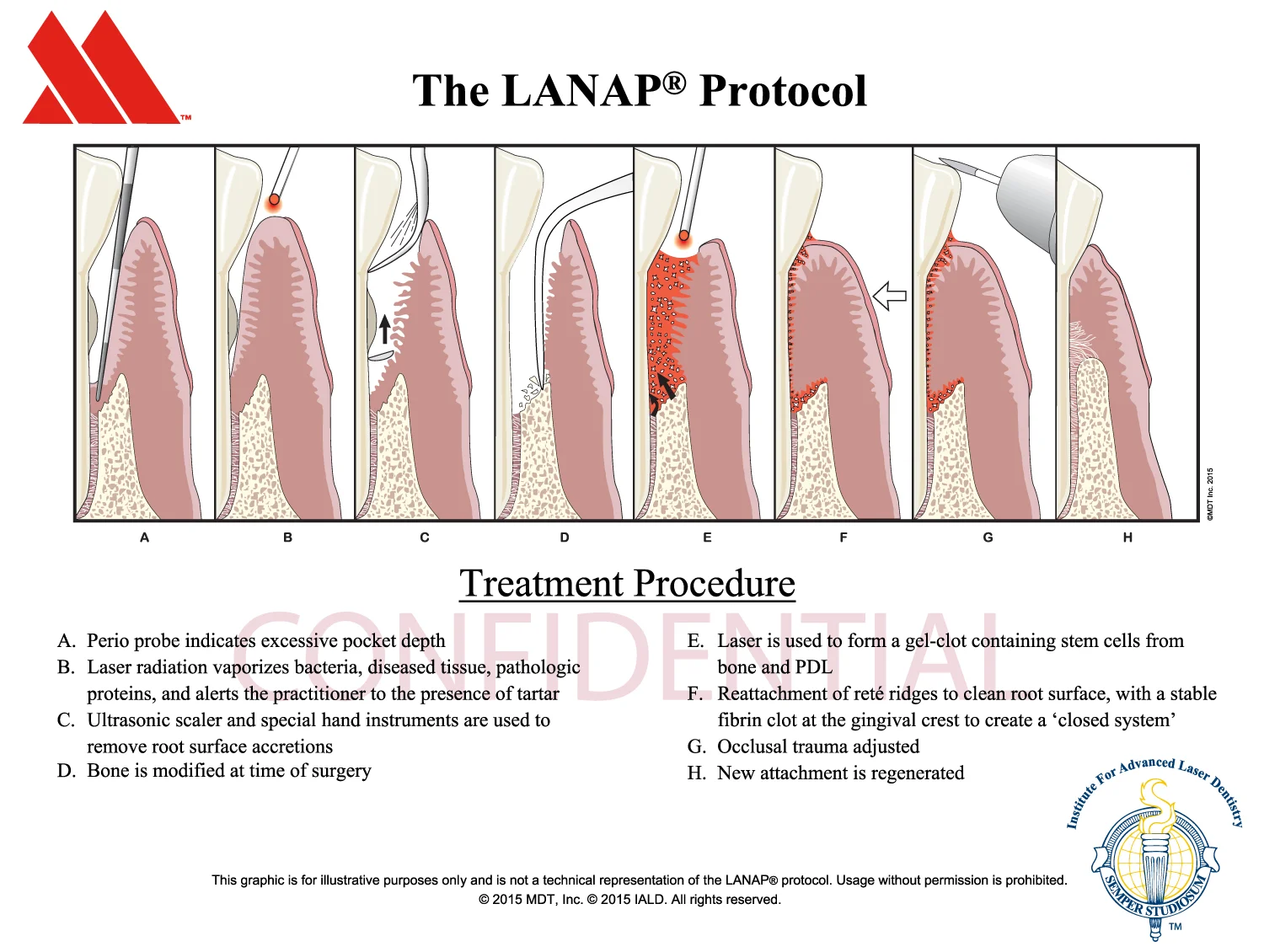 Dr. Bhandaru and Carrollton Smiles is excited to be a LANAP® certified clinician for treating gum disease with a patient-friendly and less invasive procedure. Patient care and patient comfort is always our priority and we feel laser technology will continue to support our values.
Dr. Bhandaru and Carrollton Smiles is excited to be a LANAP® certified clinician for treating gum disease with a patient-friendly and less invasive procedure. Patient care and patient comfort is always our priority and we feel laser technology will continue to support our values.
Did you know that over 50% of American adults have gum disease1? If you suffer from bleeding gums, swollen gums, tooth pain, you are likely one of those 50%. Gum disease is an infection below the gum line and is linked to several health problems – such as heart disease, stroke, diabetes and pre-term babies. Surprisingly, only a small percentage of adults get the treatment they need. Traditional gum disease treatment options involve cutting the gum tissue or extracting the teeth.
Gum disease starts when a sticky film, known as plaque, forms on the teeth, and minerals in your saliva cause it to harden into tartar, also called calculus. Certain bacteria found in plaque and tartar can harm gum tissue, leading your body to respond with an inflammatory reaction. White blood cells are sent to the affected area to fight the bacteria, which can cause the gums to become inflamed and bleed easily during brushing or flossing. This early stage of gum disease is referred to as gingivitis.
If the infection and inflammation continue unchecked, they can lead to a more severe, long-lasting condition. In this advanced stage, known as periodontitis, not only the gums but also the ligaments and bone surrounding the teeth are damaged, often without noticeable symptoms.
Several common risk factors contribute to the development of periodontitis, including genetics, high stress levels, neglecting dental visits, poor oral hygiene, and certain medical conditions. Smokers, in particular, are at a much higher risk of developing gum disease compared to non-smokers.
Gum disease has also been linked to other more serious health problems, including: alzheimer’s disease, stroke, respiratory disease, breast cancer, heart disease, pregnancy complications, kidney cancer, rheumatoid arthritis, pancreatic cancer, blood cancer, diabetes, osteoporosis.
The LANAP® protocol procedure offers a laser-based approach to treating gum disease without the need for cutting or stitches. Most patients experience less pain and discomfort both during and after the treatment compared to conventional periodontal surgery. This minimally invasive technique allows patients to regain their oral health with greater comfort, often reducing anxiety. By being less invasive than traditional methods, the LANAP procedure helps preserve the natural appearance of your smile.
Cleared by the FDA in 2004, the LANAP protocol is a patented treatment for periodontal disease. It utilizes the PerioLase® MVP-7, a specialized laser that targets harmful bacteria associated with gum disease while preserving healthy tissue. This advanced method significantly reduces post-treatment gum recession and tooth sensitivity, which are common concerns with traditional gum surgeries.
Non-invasive procedures offer patients a much better experience. Some of the key points to fighting gum disease with LANAP® protocol include:

A. Perio probe indicates excessive pocket depth.
B. Laser radiation vaporizes bacteria, diseased tissue, pathologic proteins, and alerts the practitioner to the presence of tartar.
C. Ultrasonic scaler and special hand instruments are used to remove root surface accretions.
D. Bone is modified at time of surgery.
E. Laser is used to form a gel-clot containing stem cells from bone and PDL.
F. Reattachment of reté ridges to clean root surface, with a stable fibrin clot at the gingival crest to create a ‘closed system’.
G. Occlusal trauma adjusted.
H. New attachment is regenerated.
LANAP (Laser-Assisted New Attachment Procedure) periodontal surgery is a cutting-edge, full-mouth treatment typically completed in two sessions. Each session lasts around two hours, during which we treat one side of your mouth at a time. These appointments are usually spaced about a week apart. The great news? Most patients find they can quickly return to work or other normal activities shortly after each visit.
For the first few days following your LANAP treatment, it’s normal to feel some mild aching, throbbing, or soreness in the treated areas—nothing that some over-the-counter pain relievers can’t handle. You might notice that your gums look a bit discolored, and your bite could feel slightly off at first. Don’t worry—your teeth will gradually adjust. It’s crucial to avoid brushing or flossing the treated areas for 7-10 days after the procedure. During this time, stick to a soft or liquid diet to help the healing process along. And remember, smoking can hinder your results, so it’s best to avoid it during recovery.
As your gums heal, you may notice your teeth shifting slightly, which is completely normal. However, it could require a few bite adjustments over the next few months. In some cases, we may recommend custom splints to help stabilize your teeth while they heal. It’s vital that you wear these splints as directed to ensure your recovery goes smoothly. Additionally, you’ll need professional cleanings every three months for at least the first year following surgery—this helps keep your gums healthy and the results long-lasting.
LANAP is ideal for patients dealing with moderate-to-severe gum disease who are looking for a less invasive treatment option. It’s also great for individuals who want to avoid conventional gum surgery or who are on certain medications, such as blood thinners. With the LANAP protocol, there’s no need to stop your regular medications, which makes it a safer option for many patients.
Ignoring gum disease isn’t just a dental issue—it can have serious implications for your overall health. Studies show that people with periodontal disease are nearly twice as likely to suffer from coronary artery disease and have a higher risk of fatal heart attacks. Gum disease has also been linked to numerous other health problems, including diabetes, respiratory disease, Alzheimer’s, certain cancers, stroke, osteoporosis, erectile dysfunction, HPV, and even complications during pregnancy. Treating gum disease is about protecting your total health, not just your smile.
Yes, it can! Using the same laser technology as the LANAP procedure, we can help stabilize loose or failing dental implants with a specialized treatment called the LAPIP™ protocol. While the approach is slightly different—using adjusted laser settings and exposure times—it effectively eliminates harmful bacteria and toxins around the implant, promoting stabilization and healing.
Contact Carrollton Smiles for a consultation if you are experiencing tooth pain or any signs of gum disease.
1 CDC “Periodontal Disease”, July 10, 2013, https://www.cdc.gov/oralhealth/conditions/periodontal-disease.html
If you're ready to schedule an appointment with Dr. Bhandaru, we invite you to take the next step by clicking the 'Book a Consultation' link below. Alternatively, feel free to email us, and our team will be delighted to assist you in setting up your appointment.